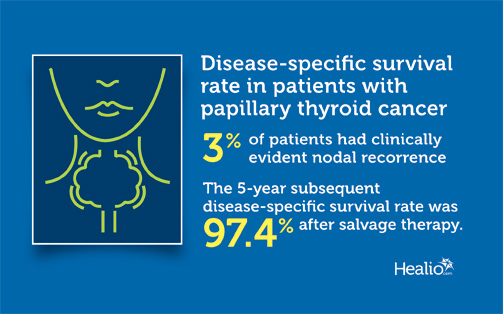Patients with papillary thyroid cancer show 3% clinically evident recurrence
Just 3% of patients with papillary thyroid cancer experienced clinically evident recurrence, and the majority of recurrences were successfully salvaged by adjuvant therapy and surgery, according to findings recently published in Clinical Endocrinology.
“There is great controversy about the true incidence of recurrence in papillary thyroid cancer,” Laura Y. Wang, MBBS, MS, of the department of surgery, head and neck service at Memorial Sloan Kettering Cancer Center, and colleagues wrote. “Long-term overall [papillary thyroid cancer] rates are commonly referenced at 30%. However, recurrence rates vary widely depending on the extent of primary disease and on the method of recurrence measurement. Although prognostic factors of [papillary thyroid cancer] have been extensively investigated, patient outcomes after clinically evident nodal recurrence remain unclear.”
Wang and colleagues reviewed an institutional database, evaluating records of 3,664 patients who underwent surgery for thyroid cancer between 1986 and 2010. The researchers excluded patients with non-papillary histology, as well as those with distant metastases or gross residual disease, leaving a cohort of 3,344 cases. For those who experienced recurrence, Wang and colleagues recorded subsequent therapies and determined disease-specific survival, distant recurrence-free survival and nodal recurrence-free survival.
Median age was 41 years at the time of initial diagnosis. Three percent (n = 99) of patients experienced clinically evident nodal recurrence, Wang and colleagues reported. Most (59%) were women. More than half had pT3 or pT4 tumors (63%), and 78% had nodal disease, the researchers wrote. A median of 28 months elapsed before clinically evident recurrence.
Seventy-four patients (75%) had lateral neck nodal recurrence, while 15% had recurrence in the central neck and 10% had recurrence in both locations. The 5-year subsequent disease-specific survival rate was 97.4% after salvage therapy, while 5-year distant recurrence-free survival was 89.2%, and 5-year nodal recurrence-free survival was 93.7%, the researchers reported.
Wang and colleagues acknowledged that the study was limited by its retrospective nature, which did not account for changes in follow-up management over time, and by its “relatively short” follow-up period.
“It may be likely that with additional follow-up, [disease-specific survival] and [distant recurrence-free survival] may decrease,” the researchers wrote. “However, as nodal recurrence events tend to occur early, we expect that [nodal recurrence-free survival] would remain the same with additional follow-up.” – by Andy Polhamus
Disclosure: The researchers report no relevant financial disclosures.

